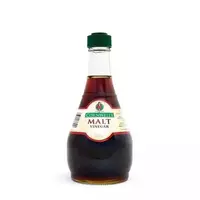Malt vinegar

The most common product called malt vinegar is in the UK and Canada, where it is considered one of the favorite and frequently used condiments. Outside of these countries, however, true malt vinegar is quite rare, and its cost is very high. Therefore, if malt vinegar is sold at a suspiciously low price, most likely, the manufacturer simply dyed caramel with ordinary alcoholic vinegar.
Meanwhile, barley grains are needed to produce quality malt vinegar. At the beginning of manufacture, barley is soaked in water, which softens the grains and stimulates the process of its germination. By the way, as you know, during grain germination, special enzymes are released that contribute to the transformation of starch into sugar. This is how it is customary to get maltose - in other words, malt sugar. After that, the resulting mass is merged into barrels, which are made from fragrant species of wood - for example, birch or beech. In such barrels, barley grains undergo a fermentation process lasting more than one month.
The result is malt vinegar, which is distinguished by three varieties: dark, light, as well as distilled. The first malt vinegar features a dark brown color and strong aroma with caramel notes. It is noteworthy that when cooking hot meat and fish meals, this sweet smell disappears. If this type of malt vinegar is used for marinade, the finished dish has a more intense tart taste. That's why if you need to give fish roasted a richer flavour accent, feel free to use dark malt vinegar.
The relatively light malt vinegar can be said to be characterized by a pale yellow colour with a reasonably mild aroma and subtle notes of fresh fruit. Most often, it is added as a necessary component in a variety of sauces and marinades, as well as seasoning to salads. For example, it is light malt vinegar that is present in the traditional English cuisine, which is fish and French fries - fish and chips.
Distilled or otherwise colorless malt vinegar is mostly used by culinary experts in the preparation of marinades and canned vegetables. Its essential advantage is also that it retains the natural color of the products, while darker types of malt vinegar slightly color them brownish. In addition, such vinegar perfectly retains the appearance of light-colored fruit and vegetable crops. For colorless malt vinegar, there is a rather sharp taste with light aromatic notes.
54 kCal malt vinegar
Energy value of malt vinegar (Ratio of proteins, fats, carbohydrates - ju):
Proteins: 0.3 g (~ 1 kCal)
Fats: 0 g (~ 0 kCal)
Carbohydrates: 13.2 (~ 53 kCal)
Energy ratio (bj | y): 2% | 0% | 98%
 Español
Español Français
Français Português
Português Русский
Русский 简体中文
简体中文 繁體中文
繁體中文 日本語
日本語 한국어
한국어 العربية
العربية Türkçe
Türkçe Қазақ
Қазақ Deutsch
Deutsch Italiano
Italiano Українська
Українська
